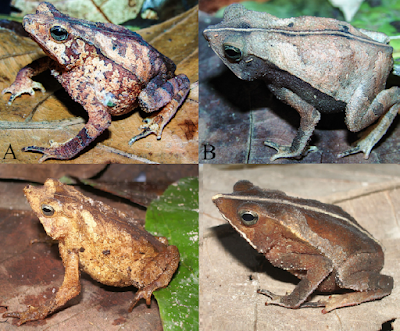Abstract
Curcuma maxwellii sp. nov. and Curcuma rubroaurantiaca sp. nov. (Zingiberaceae, Zingiberoideae, Zingibereae), two new red-orange-flowered species from Thailand, are described. They are compared to the morphologically closest species from the Curcuma subgen. Ecomatae and detailed descriptions, colour plates and information on their distribution, ecology, phenology and uses are provided. Preliminary IUCN conservation assessments for both of these species are proposed as Least Concern
Key words: Curcuma flammea, Curcuma lindstromii, Curcuma rhomba, gingers, subgenus Ecomatae, Least Concern, Zingibereae
Curcuma (Ecomatae) maxwellii Škorničk. & Suksathan, sp. nov.
Diagnosis: Similar to Curcuma rhomba Mood & K.Larsen in general habit and flower colour, but differs by bracts green to green with slight reddish tinge, puberulent on both sides (versus solid dark red glossy bracts, glabrous on both sides), bracteoles present (vs. bracteoles absent), calyx puberulent throughout (vs. calyx glabrous, except few hairs on teeth), anther with 2–2.5 mm long narrowly conical spurs (vs. ca. 1 mm short broadly conical spurs with blunt apices).
Distribution: Only known from Chiang Mai and Chiang Rai Provinces, N Thailand.
Eponymy: We name this species after our late colleague and remarkable botanist James Franklin Maxwell (1945–2015), also known simply as Max, who collected this species in 1992 (Fig. 2). With more than 32,000 high quality collections, rich in flowers and/or fruits and carefully prepared with many duplicates and mostly with labels that contain much information, Max ranks amongst the best collectors of Thai plants (van Welzen 2023).
Vernacular name and uses: As the vernacular name Wan Pet Ma (ว่านเพชรม้า) is used on several orange-flowered species with red corolla lobes including this species, we propose to use Wan Pet Ma Lanna (ว่านเพชรม้าล้านนา) for this species. Based on the information from the local herbal specialist of the Hmong community, this species, which is locally abundant, has no medicinal uses and only has potential as an ornamental plant.
Curcuma (Ecomatae) rubroaurantiaca Škorničk. & Soonthornk., sp. nov.
Diagnosis: Similar to Curcuma maxwellii by general habit and flower colour, but differs by leaf blades abaxially densely puberulent (vs. glabrous), inflorescence composed of up to 14 fertile bracts (vs. inflorescences composed of 15–34 bracts), bracteoles absent (vs. small bracteoles present), larger stamen 19–22 mm long (vs. 16–18 mm long), anther 16–17 mm long with flattened spurs, prominent anther crest 2–3 mm long with central longitudinal groove and anther thecae forming narrowly rhomboid shape (vs. anther 13–14 mm long with conical spurs, thick anther crest ca. 1 mm long without central longitudinal groove and anther thecae forming narrowly obovate shape).
Distribution: Known to occur in Loei, Sakon Nakhon, (NE Thailand), Chayaphum (E Thailand) and Phetchabun Provinces (N Thailand).
Etymology: The specific epithet refers to its bright red and orange flowers.
Vernacular name and uses: Similarly to the previous species, the vernacular name Wan Pet Ma (ว่านเพชรม้า) is used also on this species; we, therefore, propose refining the vernacular name to Wan Pet Ma Isan (ว่านเพชรม้าอีสาน) for this species. No uses were reported, but the species has a good potential as an ornamental plant.
Jana Leong-Škorničková, Sutthinut Soonthornkalump, Anders Jan Lindström, Sira Niwesrat, Sarah Qing Lim and Piyakaset Suksathan. 2023. Curcuma maxwellii and C. rubroaurantiaca (Zingiberaceae, Zingiberoideae), Two New Species from Thailand. PhytoKeys. 235: 237-248. DOI: 10.3897/phytokeys.235.111400










































